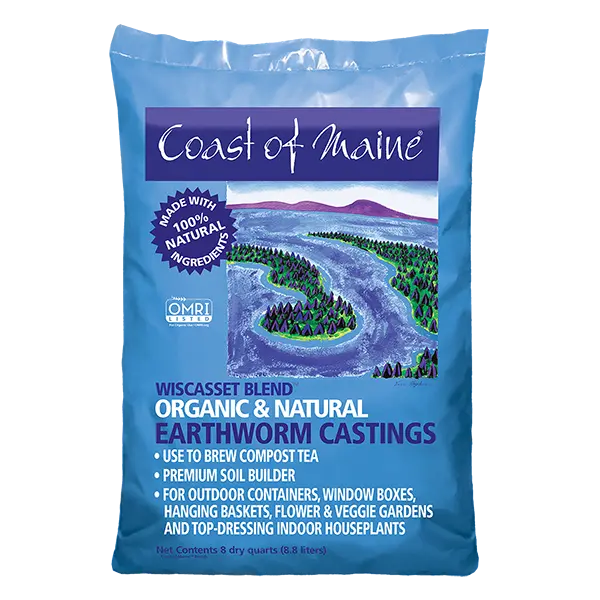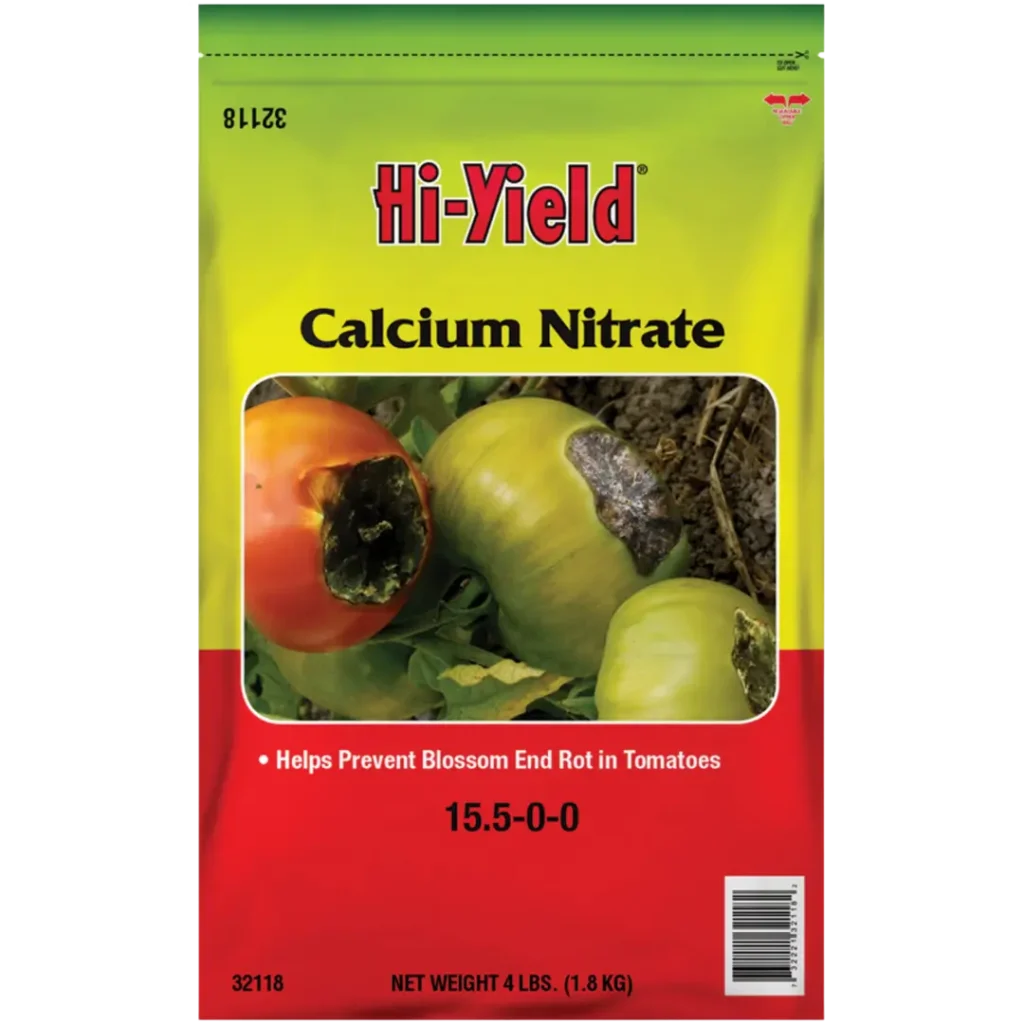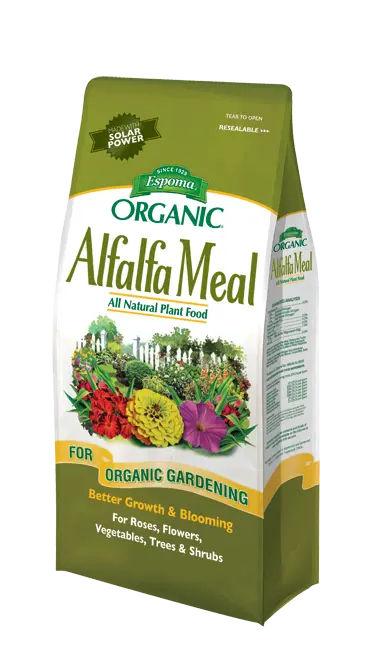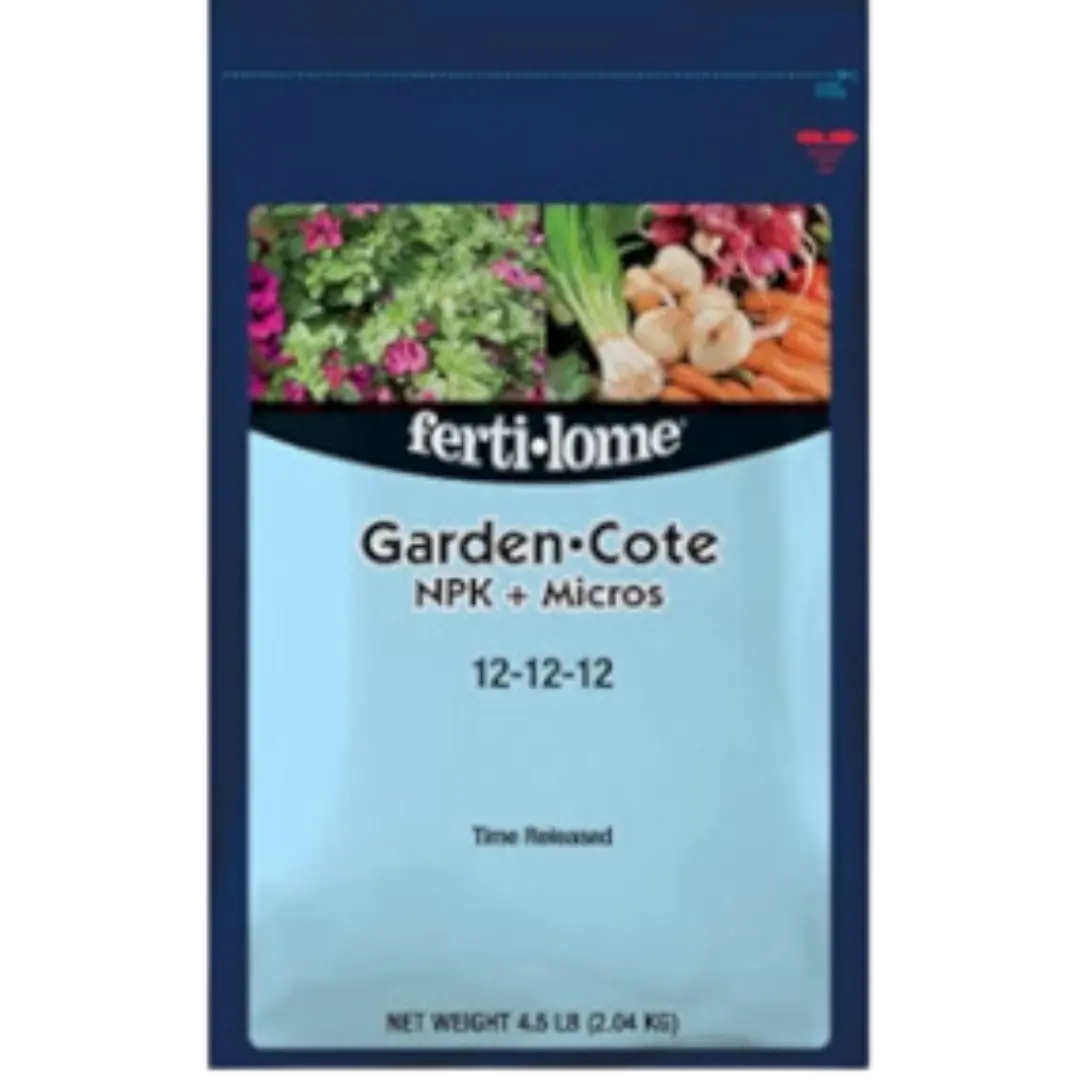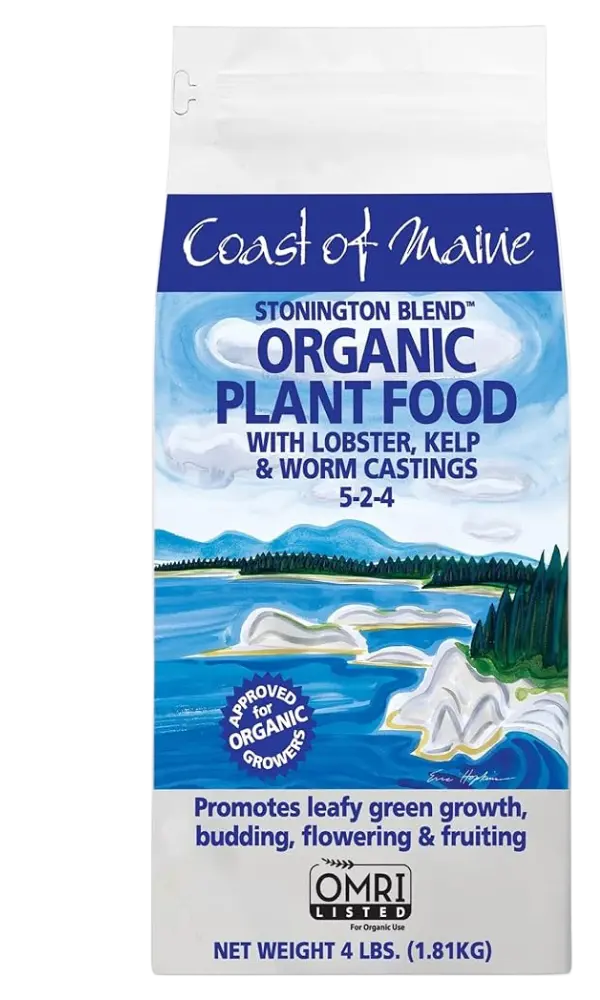Regular fertilization ensures that plants receive the nutrients that they need, promoting healthy growth and vibrant blooms. Even our top-quality soils will become depleted of essential nutrients such as Nitrogen, Phosphorus, Potassium and Calcium over time. In fact, our best soil can provide essential nutrients for only 3 months before becoming depleted due to nutrient needy plants. Consequently, YOU GOTTA FERTILIZE!!!
Martin Garden Center’s fertilizer offerings include the top organic and inorganic fertilizers on the market featuring Coast of Maine, Espoma, Ferti-lome & Hi-Yield, as well as water soluble products from Jack’s, Bonide and Espoma. Look for our TOP RECOMMENDATION amidst these summaries.
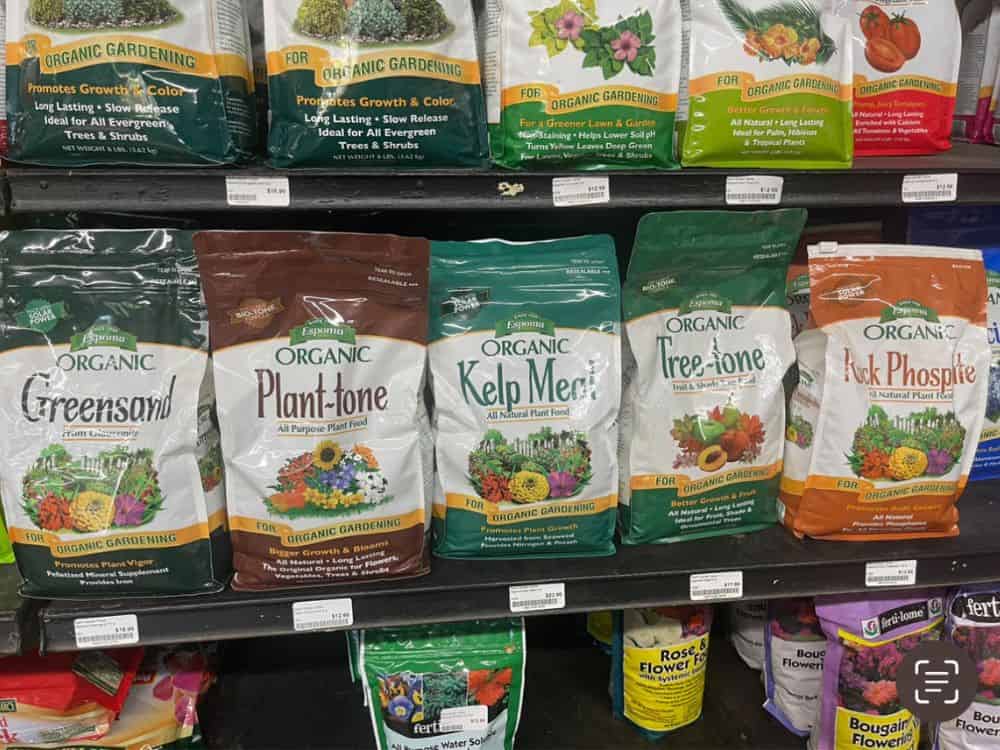
Benefits of Using Fertilizer
Fertilizers play a crucial role in providing essential nutrients that significantly enhance plant growth, health, and productivity. By supplying key nutrients like nitrogen, phosphorus, and potassium, fertilizers promote more vigorous growth and higher yields. They also improve root development, which strengthens the plants’ ability to absorb nutrients and water effectively. Furthermore, the application of fertilizers enhances flowering and fruit production, boosting flower and fruit set and resulting in more bountiful harvests.
Beyond immediate plant benefits, fertilizers contribute to long-term soil health and quality. Nutrient enrichment through fertilizers replenishes essential nutrients that are depleted by plant uptake and environmental factors. Organic fertilizers, in particular, improve soil structure by enhancing soil texture and increasing organic matter content, which aids in water retention, drainage and aeration.
Explaining Types of Fertilizers
Organic Fertilizers
Organic fertilizers are derived from natural sources such as plant and animal materials. They are a great choice for gardeners looking to enhance their soil’s health while supporting sustainable practices. Organic matter improves soil texture, water retention, and aeration while providing a slow release of nutrients that promotes steady plant growth. Organic fertilizers enhance biodiversity.
Inorganic “Synthetic” Fertilizers
Inorganic fertilizers are manufactured through chemical processes. They offer precise nutrient formulations that are often more concentrated than organic options and quicker to release, which is beneficial for fast-growing plants. Synthetic fertilizers’ uniform nutrient content ensures predictable results. They are easy to use with their granular or liquid forms and are less costly than the organic fertilizers.
Within the universe of synthetic fertilizers, there can be slow-release fertilizers and immediate water soluble fertilizers.
Slow-release fertilizers, also known as controlled-release fertilizers, are designed to provide a gradual and sustained supply of nutrients to plants over an extended period. These fertilizers are particularly useful for maintaining consistent nutrient levels in the soil, reducing the need for frequent applications, ergo the lazy gardener’s fertilizer.
The key feature of slow-release fertilizers lies in their coated pellets. These encapsulations contain the fertilizer granules, creating a semi-permeable barrier. The coatings respond to environmental conditions, such as temperature, soil moisture and microbial activity. When conditions are favorable (e.g., warm and moist), the coatings allow nutrients to diffuse out slowly. Conversely, during cold or dry periods, nutrient release decreases.
The number of layers on coatings of slow-release fertilizer granules vary. The least coated pellets release their fertilizer almost immediately and then the slightly more coated granules are released later, followed by the more coated, etc. As the varying layers of coatings dissolve over time, nutrients are released gradually, thus resulting in a controlled release of nutrients.
Water-soluble fertilizers are a convenient and efficient way to provide immediate nutrients to plants. These fertilizers come in a soluble powder or granular form that readily dissolves in water. When mixed with water, they create a nutrient-rich solution that can be directly applied to the soil or sprayed onto foliage.
Water-soluble fertilizers allow precise control over nutrient ratios, making them versatile for both indoor and outdoor plants. Foliar application (spraying the fertilizer directly on leaves) is possible with water-soluble fertilizers, providing nutrients directly to the plant’s tissues. Since the nutrients are readily available, plants respond quickly. However, if water soluble fertilizers are the only fertilizer used, frequent applications are necessary because they don’t provide long-term nutrient storage like slow-release fertilizers.
Understanding Fertilizer Labels
Fertilizer labels provide crucial information about nutrient content and application rates. Understanding these labels helps you choose the right product for your garden.
- N-P-K Ratios: The N-P-K ratio represents the percentages of nitrogen (N), phosphorus (P), and potassium (K) in the fertilizer. Nitrogen promotes leafy, green growth, Phosphorus supports root development and flowering, and Potassium enhances overall plant health and disease resistance.
- Guaranteed Analysis: Lists the nutrient content and their percentages.
- Application Instructions: Provides guidelines on how much fertilizer to use and how to apply it.
- Additional Ingredients: Information about secondary nutrients and micronutrients.
Our Fertilizer List
At Martin Garden Center, we have spent years honing the fertilizers we offer to our customers. We will, on occasion, add another fertilizer if we believe it provides something more. But, for the most part, our list is limited to the following fertilizers:
- Coast of Maine because they provide premium organic fertilizers, most of which are OMRI listed.
- Espoma because they have the most extensive offerings for specific plant species and because their base use of composted, dried and pelletized chicken poop is AWESOME! Also, their “Tones” fertilizers are loaded with calcium, a mineral that is deficient in our native soil, Piedmont Ultisols, and they also add beneficial bacteria and humic acids to the Tones. Bravo Espoma!
- Hi-Yield fertilizer because they are THE most cost-effective fertilizers we offer, albeit synthetic. And, Hi-Yield’s parent company, TPG, is dedicated to selling exclusively to independent garden centers.
- Ferti-lome, also a line with TPG, because of their extremely well-priced liquid root starter and liquid fish emulsion fertilizer.
- Bonide because it has liquid fertilizers for houseplants african violets and cactus that are the perfect 8 oz size, and bon-tone rooting hormone also in the perfect sizes.
Each of the fertilizers from the above listed brands are discussed in more detail in the sections that follow.
Don’t forget that Black Kow brands Mushroom Compost and Cow Manure have naturally occurring organics in their soil are also a source of nitrogen, phosphorus and potassium.
Coast of Maine Fertilizers
Fish Bone Meal Organic Plant Food for Buds & Blooms (5-13-0, 18% Ca) – So with our native soil, Piedmont Ultisols, devoid of Calcium, we decided to try out this organic fertilizer containing the highest calcium content of any of the organic fertilizers. Still evaluating.
Squid Concentrate All Natural Plant Food for Indoor Plants (2-3-0, ??) – This all organic supplement made from food-grade squid residues and ink sacs is unique to say the least. We carry 32 oz concentrate.
Stonington Blend Organic Plant Food with Lobster and Worm Castings (5-2-4, 4% Ca – OMRI) – This amazing OMRI listed plant food provides lobster for calcium and earth worm castings to hurry up the humus making. We carry 4 lb bags.
Wiscasset Blend Earthworm Castings (OMRI) – Countless studies point to the benefits of worm castings. Why, why, why are people passing up this resource? TOP RECOMMENDATION. It is a pest deterrent. It feeds the beneficial bacteria and enzymes that results in healthier plants.
Castings are rich in nutrients such as phosphorous, potassium, calcium, magnesium, iron, and manganese. We love worm poo (we mean castings). It is the single best overall organic amendment on the planet. We carry 8qt bags.
Espoma Organic Fertilizers (The Tones)
We don’t carry all off Espoma’s fertilizers. For example, Potash and Triple Super Phosphate are available from other vendors and are less expensive. Espoma Chicken Manure is great, but Tomato Tone has comparable constituents. We’ve tried to be selective so that we provide great selections but no overlap.
Espoma’s most popular fertilizers are the “Tones,” which all end with the word tone, such as Holly Tone or Iron Tone. The main component of all the “Tones” is composted, dried and pelletized chicken manure. So, the Tones may be a little smelly, but the smell dissipates in 2-3 days. If you bury the fertilizer it helps. Note that all of the Tones carry beneficial microbes/bacteria … thank you Espoma. A list and description of the benefits of each of the Tones follow:
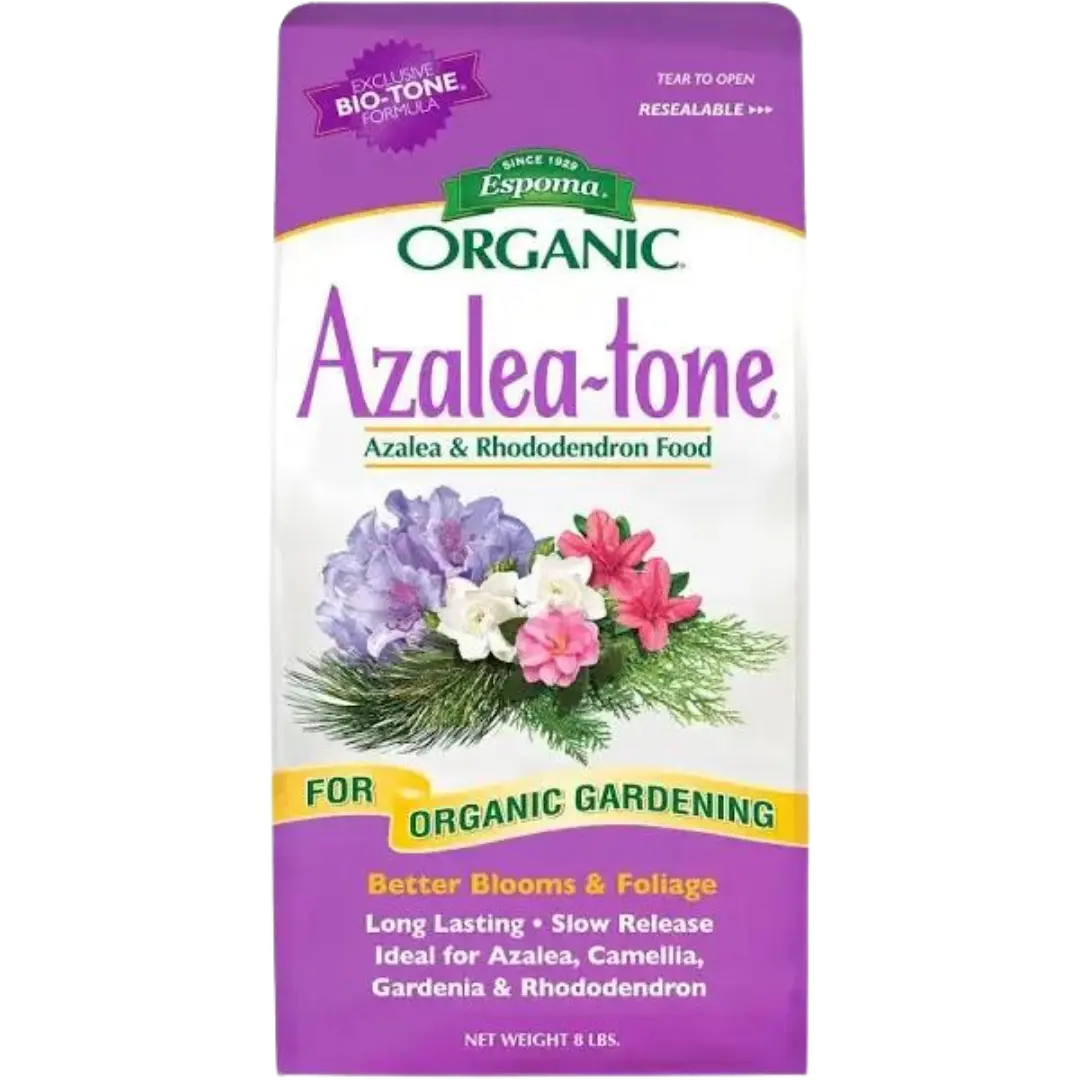
- Azalea Tone – Same content as Holly Tone but with different packaging accentuating azaleas. See Holly Tone for more instruction. We carry 4 lb bags.
- Berry Tone – Same content as Holly Tone but with different packaging accentuating azaleas. See Holly Tone for more instruction. We carry 4 lb bags.
- Bio-Tone Starter Plus (4:3:3, 5% Ca, 1% Mg, 1% S, with Mycorrhizal fungi) – OUR #1 TOP RECOMMENDATION … This is a starter fertilizer so don’t waste it … you must use it only when planting, and it must be added in adjacent to the root system. We’ve found that if you wet the root ball and rub it on before filling in your soil, you maximize your bang for the buck. The Mycorrhizal fungi colonize the roots of the plant and brings in additional water and nutrients … it works wonders. Our #1 best-selling organic fertilizer for a good reason!!! We carry 4 lb & 18 lb bags, and occasionally 5 oz packets.
- Bulb-Tone (3-5-3, 6% Ca, 1% Mg, 1% S & 1% Humic Acids) – Use by placing in the hole when planting Spring and Fall bulbs. For existing bulbs, broadcast apply after flowers have bloomed. We like the Espoma Bone Meal better because it has 12% Ca … just saying. We carry 4 lb bags.
- Citrus-Tone (5-2-6, 5% Ca, 0.5% Mg, 1% S and 1% Humic Acids) – Perfectly formulated for citrus, which are indoor plants in the South Carolina Upstate (we are Zone 7 and 8 and citrus is Zone 9 or 10). We carry 4 lb bags.
- Evergreen-Tone (4-3-4, 5% Ca, 1% Mg, 5% S & 1% Humic Acids) – For evergreen trees and shrubs. We carry 8 lb bags.
- Flower-Tone (3-4-5, 5% Ca, 0.5% Mg, 1% S & 1% Humic Acids) – Apply monthly from March through October … just 1.5 tsp per 4″ plant. Perfect overall choice for fertilizing perennial and annual flowers. We carry 4 lb bags.
- Garden-Tone (3-4-4, 5% Ca, 1% Mg, 2% S, & 1% Humic Acids) – Excellent for herbs and veggies … See Tomato Tone for the Calcium needy veggies. For herbs, see the instructions on the back of the bag as you only apply once each season for herbs. We carry 4 lb and 18 lb bags.
- Holly-Tone (4-3-4, 5% Ca, 1% S, & 1% Humic Acids) – For all acid loving plants which basically means all plants. This is our #2 best-selling organic fertilizer, and all Martin Garden Center staff buy it and use it … must mean it’s good!!! Apply in the spring before growth starts and in the fall after leaves have fallen. Most people want specific application dates so, in the South Carolina Upstate, apply on St. Patrick’s Day (green day) and Thanksgiving (after you feed yourself, go feed your plants). You can apply as early or as late as you want in the Upstate, so don’t worry if you miss these dates. Your only limitation is don’t apply if the ground is frozen and that doesn’t happen in the Upstate (or rarely does it happen). We carry 4 lb & 18 lb bags. The 18 lb bag is much more economical.
- Iron-Tone (3-0-3, 5% Ca, 0.7% Mg, 17% S & 6% Fe)- Guess what … our native soil Piedmont Ultisols has enough iron to never need this so buy only if you have raised beds or non-native soil. In containers, Iron-tone may be helpful because most bagged soils are iron deficient. However, before buying Iron-tone for your yellowing plant, consider buying Magnesium Sulfate (see discussion below). We carry 4 lb bags.
- Palm-Tone (4-1-5, 5% Ca, 0.5% Mg, 1% S & 1% Humic Acids) – Perfectly formulated for Palm Trees and tropical plants, and their s l o w g r o w t h. Note that tropicals such as hibiscus also love this potassium heavy food. Feed every 3 months. We carry 4 lb bags.
- Plant-Tone (5-3-3, 3% Ca, 1% Mg, 1% S & 1% Humic Acids) – This all-purpose plant food comes in the little brown bag. It is Martin Garden Center’s 3rd best-selling organic fertilizer. We carry 4 lb & 18 lb bags.
- Rose-Tone (4-3-2, 5% Ca, 0.5% Mg & 1% Humic Acids) – Perfectly formulated for the needs of roses. We carry 4 lb bags.
- Tomato-Tone (3-4-6, 8% Ca, 0.9% Mg, 2.5% S & 1% Humic Acids) – Another TOP RECOMMENDATION because it has the highest percentage calcium (8%) of the tones; use for tomatoes, peppers, squash, zucchini, and melons, plus you can use it on flowering annuals … Martin Garden Center loves Tomato-Tone. Don’t forget that our native soil, Piedmont Ultisols, is completely devoid of calcium. Tomato-tone will double your yield in tomatoes, and you can say bye-bye to blossom end rot. Apply twice per month to vegetables after planting, or don’t. If you forget to apply regularly on calcium needy plants, you will see blooms slow/stop and growth languish. Apply it again and in one-two weeks, you have new blooms and expansive growth. We carry 4 lb & 18 lb bags.
- Tree-Tone (6-3-2, 5% Ca, 0.5% Mg & 1% Humic Acids) – Perfect fertilizer for trees. Apply in the Spring and Fall.
Espoma Other Organic Fertilizers
- Alfalfa Meal (2-0-2, Organic) – Most of the Tones include Alfalfa Meal in their product. Made from fermented alfalfa seeds, this slow-release nitrogen source is purchased most often by the old-timers. Can be used to make fertilizer tea. Also popular with vegetarians and vegans (no chicken poop). We carry 3 lb bags (only size available).
- Bone Meal (4-12-0, 12% Ca, Organic) Ideal for bulbs, tubers and corms when planting … calcium content of 12%. Broadcast apply to existing bulbs in the spring and the fall. We carry 4 lb bags.
- Blood Meal (12-0-0, Organic) – Pricey but worth it. Non-burning nitrogen infusion that slowly releases over several weeks. Use with spent soil … watch for plant leaves lacking luster with a non-healthy green color. Also acts as a pest deterrent … because it is blood, the smell deters critters such as moles/voles, deer and rabbits. We carry 3 lb bags (only size available).
- Cottonseed Meal (6-2-1, Organic) – Again, the old-timers buy it and so should you. The benefits … slow-release nitrogen at a higher concentration and no chicken poop. Also popular with vegans and vegetarians. We carry 3.5 lb bags (only size available).
- Garden Gypsum – Martin Garden Center is discontinuing this product because it has greater negatives than positives. Mixing gypsum & red clay forms red cement. And, there are better fertilizers with Sulphur and Calcium. Sorry. We currently carry 6 lb bags so get them while you can.
- Garden Lime (21% Ca, 10% Mg, Organic) – Derived from dolomite lime, Espoma’s Garden Lime helps you increase the pH where needed. But, since most plants prefer acidic soil, there are rare uses for it as follows: (1) It turns your hydrangeas pink; (2) Add to your brussels sprouts to achieve a pH >7, which leads to better yields; (3) Add it to baby’s breath plants as they prefer alkaline soil; and (4) Add it to your other indoor plants that may need alkaline soils. We carry 6.75 lb bags (only size available).
- Greensand – Espoma will be discontinuing this product as the volume available does not meet demand so get it while you can. Note that Espoma uses this product in many of the Tones. We currently carry 3.25 lb bags.
- Kelp Meal (1-0-2, Organic) – Harvested seaweed from the Atlantic. It is processed at low temperatures and then dried and ground into Kelp Meal. Note that many of the Espoma Tones include this product in their mixture. Totally organic and popular for organic gardening. Available in 4 lb bags.
- Rock Phosphate (0-3-0, 1% iron, Organic) – For use in the early spring as a slow-release phosphorous source. Available in 7.25 lb bags.
- Soil Acidifier (30% S, Organic) – Made from naturally occurring sulfur compounds, not salts, that lower the pH. Turns your hydrangeas blue. Because our naturally occurring soil in the Upstate is acidic, there are rare uses for this product when planting in the ground. However, it may be useful when planting in pots filled with potting mix. Available in 6 lb bags.
- Orchid Bloom Booster (1-3-1, 1% Ca) – This is the only liquid orchid fertilizer readily available so that’s why we carry it. The liquid concentrate also contains beneficial bacteria. We offer this in 8 oz concentrate.
Espoma Inorganic Fertilizers
- Urea 45-0-0 – Straight infusion of nitrogen … quick acting/quick release. Use sparingly. Nitrogen is consumed faster than other macronutrients. Sometimes, yellowing of leaves signals oncoming chlorosis caused by a lack of nitrogen resulting from spent soil with little nitrogen but still containing other macronutrients like phosphorous and potassium. Available in 4 lb bags.
Ferti-lome & Hi-Yield Products
Ferti-lome All Purpose Water Soluble Plant Food (20-20-20) – This is a new fertilizer that we wanted to try just to see if it is comparable to other water soluble plant fertilizers. It is 20% less expensive that its nearest competitor so we’re going to see if it’s equally as good. We’ll keep you up to date as we study this fertilizer’s effectiveness. We offer 1.5 lb bags.
Ferti-lome Fish Emulsion Fertilizer (5-1-1) – This fertilizer provides a great bargain for a liquid fertilizer. Nutrients are readily available and easily absorbed, thus leading to faster growth and improved health. 1 tsp – 2 TBS/gallon, depending on the plant (see the instructions). We carry 16 oz liquid concentrate. It smells.
Ferti-lome Root Stimulator and Starter Fertilizer (4-10-3) – Aids in the development of stronger root structure … healthy roots, healthy plant. We use this on plugs we bring in to repot. And, we soak all of our tubers, bulbs and corms in this before planting. We recently began to soak all our cuttings in this prior to propagation, which resulted in an even better propagation rate. Perfect for use in transplanting … helps mitigate transplant shock. It is the most cost-effective of all the liquid root stimulators on the market. After soaking plants/tubers, we use the remaining used liquid to water in our plantings. 3.5 TBS/gallon. Available in 32 oz liquid concentrate.
Ferti-lome Garden Cote (12-12-12, 0.6% Mg, 6.1% S, 0.33% Fe, 0.06% Mn) – LOVE, LUV, LERVE this product. For 10+ years, we have added this fertilizer to every plant we grow/pot up at Martin Garden Center. That is more than 50K plants each year. It makes a difference, my friend… a huge difference. This is the lazy man’s (or woman’s) fertilizer because you only add it once when you plant in the spring and then add it again when you plant in the fall, as it is a 6-month slow-release feed. Our only complaint … no calcium. We offer 1 lb & 4.5 lb bags. TOP RECOMMENDATION.
F
Ferti-lome Premium Bedding Plant Food (7-22-8, 0.02% B, 0.05% Cu, 0.1% Fe, 0.05% Mn, 0.05% Zn) – This fertilizer is the bomb … a slow release with micronutrients. It is high in phosphorous to promote blooming. Our only complaint … no calcium. Add every month during the growing season (in the Upstate, that runs from April 15th through September 15th for spring/summer, and then for fall winter, continue fertilizing pansies and snapdragons every two months ish. We offer 4 lb & 16 lb bags.
Hi-Yield Magnesium Sulfate, Epsom Salts (9.5% Mg, 12.5% Sulfate) – Every homeowner should buy a bag of Epsom Salts. Magnesium (Mg) builds cell walls and is necessary for photosynthesis in plants, and photosynthesis is what keeps the plants green. So absent Mg, plants may yellow because they can’t utilize the macronutrients available to them. What causes the loss of Mg … usually we let the plants crash (dry out … badly) and so they lose their minerals (such as Mg) and go limp. We give them water again and they bounce back but unless that water is high in Mg, it doesn’t work that well. It’s like a human having heat stroke … we give humans electrolytes (minerals like Mg) to bounce back. But, when we repeatedly let out plants dry out and don’t give them back Mg, our plants can’t photosynthesize and hence their leaves turn yellow … it is called chlorosis and there are many causes of chlorosis. Most customers believe that yellowing is caused by iron deficiency. But our native soil is smack full of iron hence the red color of the clay. If plants are yellowing and they are planted in our native soil, they are getting plenty of iron, so the problem probably is magnesium deficiency, not iron deficiency. Note that it could also be nitrogen deficiency but that’s another lecture!
Can’t say enough about Magnesium Sulfate … did you know that Epsom Salts are listed as a slug and vole deterrent? You can fertilize and deter pests all at the same time. Use 1-2 TBS/gallon when watering or consider a foliar spray for absorption through the foliage. Magnesium sulfate also helps with seed germination and the sulfur helps with vitality and disease prevention. Sulfur is an essential nutrient to make enzymes, proteins and amino acids. This is a fantastic and inexpensive additive. We carry 4lb bags. TOP RECOMMENDATION and so inexpensive.
Hi-Yield Calcium Nitrate (15.5-0-0) – This inorganic fertilizer provides nitrogen and calcium boosts. Ideal for yellow foliage showing nitrogen deficiency … look for yellowing on lower leaves first and spreading to upper leaves. If there is a calcium deficiency, you will see blossom end rot and/or yellowing then browning tips/edges of leaves. Use 2-4 TBS/gallon. We carry 4 lb bags.
Hi-Yield Muriate of Potash (0-0-60) – Potash improves plant vigor and extra potassium is necessary for root vegetables (e.g., carrots, rutabaga, etc.). Available in 4 lb bags.
Hi-Yield Triple Super Phosphate (0-45-0, 15-17% Ca, 1-2.3% S) – Although not listed on the Hi-Yield bag as components in triple super phosphate, both calcium and sulfur are components of triple super phosphate (commonly called TSP). The calcium percentage helps to ensure bud set and prevent calcium end rot on your spring crops. Sulfur helps with vitality and disease prevention. Sulfur is an essential nutrient to make enzymes, proteins and amino acids.
To use TSP to maximize root growth, add only in the late fall/early winter (1 month after the first hard frost – in the Upstate, this may be late December). If added too early in the fall, plants may attempt to increase top growth or bloom. Take great caution in adding this in the spring because it is fast release and may burn if you add too much. TOP RECOMMENDATION because it is cheap and effective. And did we mention it contains calcium, which is deficient in out native soils, Piedmont Ultisols? We carry 4 lb bags.
Hi-Yield Iron Sulfate (19% Fe, 11% S) – For use to cure chlorosis, the yellowing of leaves, caused by iron deficiency. Check the discussion on Magnesium Sulfate prior to considering this chemical. Available in 4 lb bags.
Hi-Yield Iron + Soil Acidifier (11-0-0, 13% S, 16% Fe) – A nitrogen and iron boost for plants that may be yellowing (chlorosis) due to nitrogen or iron deficiencies. Check the discussion on Magnesium Sulfate prior to considering this chemical. Available in 4 lb bags.
Hi-Yield Aluminum Sulfate (16% S) – We carry this for use in making hydrangeas a more vivid blue. Available in 4 lb bags.
Jacks
Jacks manufactures a wide range of water-soluble fertilizers that are super effective. The fertilizer can be mixed in water containers for easy fertilization of small areas. For example, if your well cared for plants slowly begin to yellow, you need more nitrogen fertilizer. If you see purple overtones on the underside of the leaf, it is a phosphorus deficiency.
Jacks fertilizers are ideal for fertilizing houseplants inside your home where you can’t drag a hose. Pretty blue water. Instructions generally suggest using half the dose if fertilizing every time you water.
All Purpose (20-20-20, 0.02% B, 0.05% Cu, 0.1% Fe, 0.05% Mn, 0.001% Mo; 0.05% Zn) – This is the perfect boost to any plants languishing in your garden. No fuss, no muss. Just fertilizer. We carry 8 oz, 1.5 lb & 4 lb plastic containers.
Blossom Booster (10-30-20, 0.5% Mg, 0.02% B, 0.05% Cu, 0.1% Fe, 0.05% Mn, 0.001% Mo; 0.05% Zn) – TOP RECOMMENDATION …We forget how our plants strip the nutrients from our soils, particularly in containers. Remember, even the best soils provide only 3 months of macronutrients. Hence, all that “spent” soil in your raised bed that you’ve had for years and that old soil in your container pots that has never been replaced … that exhausted soil needs a boost. Blossom booster has high phosphorous to accommodate the “nutrient needy” blooming plants. And … it works. In 1-2 weeks, blooms are launched or re-launched. LOVE THIS. Available in 8 oz, 1.5 lb & 4 lb plastic containers … the 4 lb is more economical.
African Violet (12-36-14, 0.02% B, 0.05% Cu, 0.1% Fe, 0.05% Mn, 0.001% Mo; 0.05% Zn) – These needy little nutrient suckers love Jacks African Violet. Fertilize regularly with Jacks and African violets will stay in bloom. We carry 8 oz plastic containers. Bottom feed to avoid leaf spots … keep leaves dry at all times. We carry 8 oz plastic containers.
Citrus Feed (20-10-20, 4.9% S, 0.02% B, 0.05% Cu, 0.15% Fe, 0.075% Mn, 0.001% Mo; 0.05% Zn) – Finally a water-soluble fertilizer for indoor citrus. The high Sulphur helps in preventing so many issues … way to go Jacks. TOP RECOMMENDATION for citrus. Available in 1.5 lb plastic containers.
Houseplant Special (15-30-15, 0.02% B, 0.05% Cu, 0.1% Fe, 0.05% Mn, 0.001% Mo; 0.05% Zn – When fertilizing houseplants with Jacks Houseplant Special, it is best to continuously feed. This keeps houseplants fed and avoids highs and lows. We offer 8 oz plastic containers.
Orchid Special (30-10-10, 0.02% B, 0.05% Cu, 0.1% Fe, 0.05% Mn, 0.001% Mo; 0.05% Zn) – The first and the best. Jacks orchid special has been a hallmark at Martin Garden Center for years. Every orchid growing Southern woman (or man) uses this fertilizer and we can’t be happier with its performance. Note that the instructions specify to switch to Blossom Booster when orchids set a spike and are about to bloom and then switch back after blooming is completed. TOP RECOMMENDATION for Orchids. Thank you Jacks! We carry 8 oz plastic containers … a little bit goes a long way with orchids.
Bonide
Bonide Liquid African Violet Plant Food (7-10-7) – Perfectly sized liquid plant food for nutrient needy African violets. A little goes a long way. We carry 8 oz liquid concentrate.
Bonide Liquid Cactus Plant Food (2-7-7) – Ideal food for cacti, aloe and other succulents. Even lasts longer… We carry 8 oz liquid concentrate.
Bonide Liquid Plant Food (2-7-7) – Ideal food for houseplants in the perfect size bottle. We carry 8 oz liquid concentrate.
Bonide Bontone Rooting Powder – This rooting powder fertilizer is the bomb. We use it for all our cuttings at Martin Garden Center. TOP RECOMMENDATION when rooting cuttings (of non-patented plants, of course, because you would NEVER violate the rules and propagate a patented plant).
Choosing The Right Fertilizer
Selecting the appropriate fertilizer is essential for fostering a healthy, productive garden. You may want to conduct a soil test to determine the specific nutrient deficiencies and pH levels in your soil. This test will provide you with valuable information about which nutrients are lacking and how to amend your soil to create optimal growing conditions. Additionally, it’s important to consider the specific needs of the plants you are growing. Different plants have unique nutrient requirements; for example, leafy greens often need higher levels of nitrogen to promote lush foliage, while flowering plants may require more phosphorus to support blooming.
Another key consideration is the growth stage of your plants. Nutrient needs vary at different stages of growth: nitrogen is crucial for the vegetative phase, helping plants develop strong, healthy leaves, whereas phosphorus and potassium become more important during the flowering and fruiting stages. Environmental conditions also play a significant role in fertilizer selection. The climate and soil conditions in your area will influence the effectiveness of different fertilizers. For instance, slow-release fertilizers may be more suitable in regions with heavy rainfall to prevent nutrient leaching.
How to Apply Fertilizer
Proper application of fertilizer is crucial for maximizing its benefits and avoiding potential issues like over-fertilization. To achieve the best results, obviously follow the instructions on the fertilizer label, adhering to the specified application rates and methods. This helps ensure that your plants receive the right amount of nutrients without the risk of nutrient burn or wastage.
Even distribution is also important to prevent nutrient imbalances that can lead to uneven growth and other plant health issues. Watering the soil before and after applying fertilizer helps nutrients penetrate the soil more effectively, reaching the plant roots where they are needed most. Timing your fertilizer applications correctly is another key aspect; for most plants, the best times to fertilize are in early spring and mid-summer, which align with their active growth phases.
Common Fertilizer Issues and Solutions
Over-fertilization is a common issue that can lead to detrimental effects on plant health. Signs of over-fertilization include leaf burn, characterized by browning or yellowing of leaf edges, as well as excessive growth, which manifests as unnaturally rapid growth that weakens plants. Another indication is soil crusting, caused by salt buildup on the soil surface, which can hinder water absorption and root development.
In cases of over-fertilization, flushing the soil with water is essential to leach excess salts and restore balance. Adjusting application rates by modifying the amount and frequency of fertilizer applications based on plant response can help prevent future issues. Furthermore, incorporating soil amendments such as organic matter can improve nutrient retention and soil health, ensuring that plants receive adequate nutrition without the risk of over-fertilization.
On the other hand, under-fertilization can result in stunted growth, where plants exhibit slow or limited growth, and yellowing leaves, indicating a general nutrient deficiency, particularly in nitrogen. Additionally, poor flowering and fruiting may occur due to inadequate levels of calcium, phosphorus and potassium.

